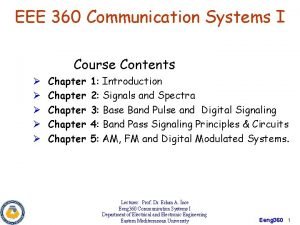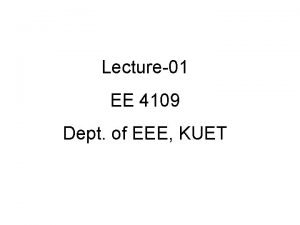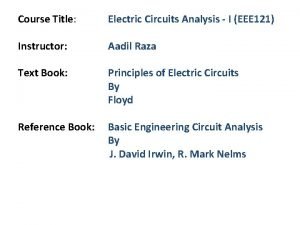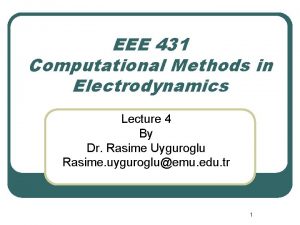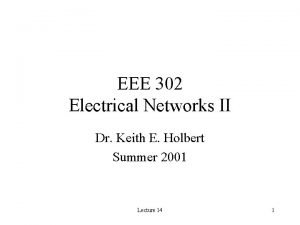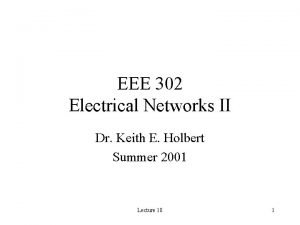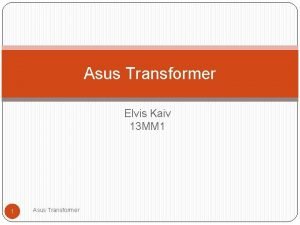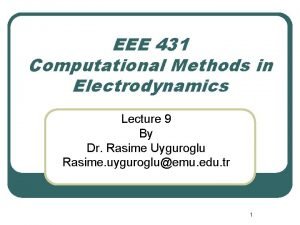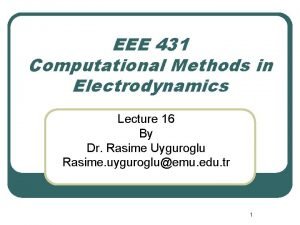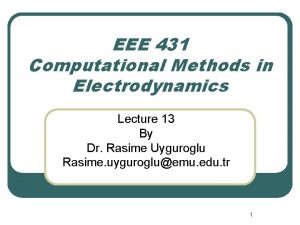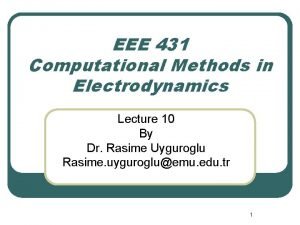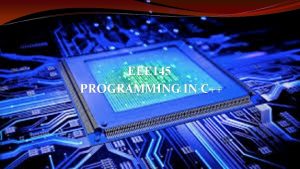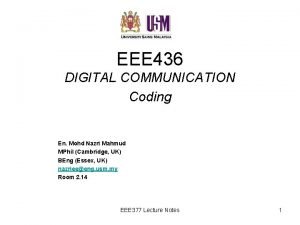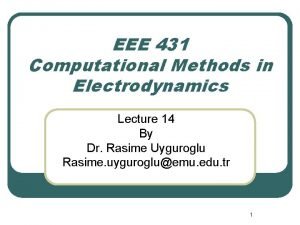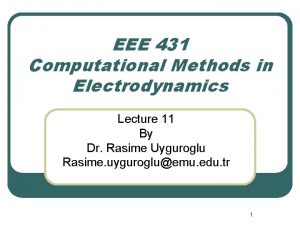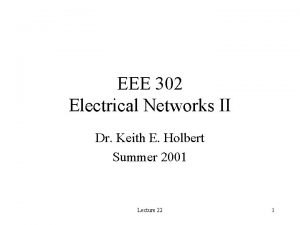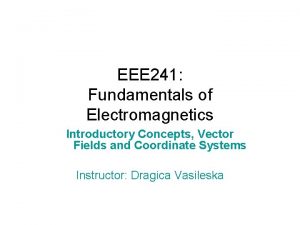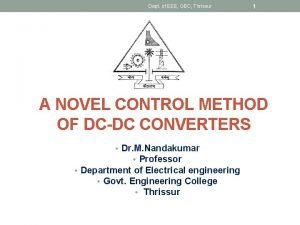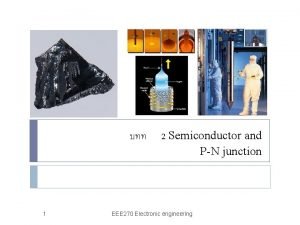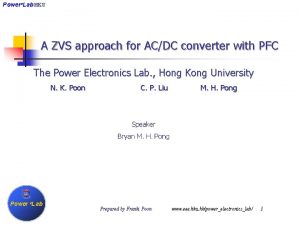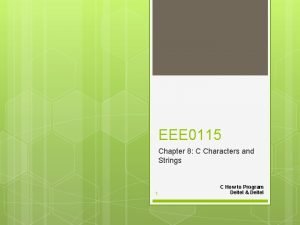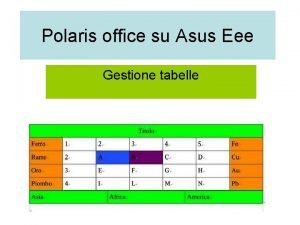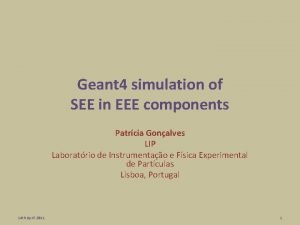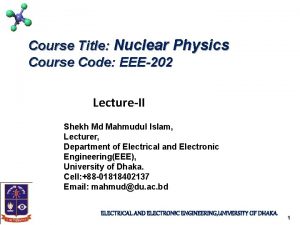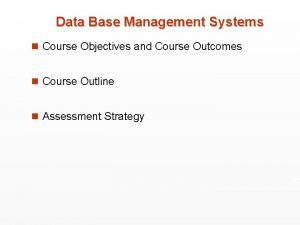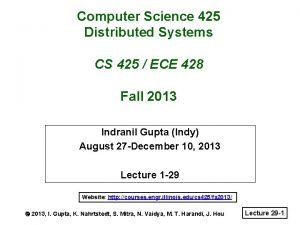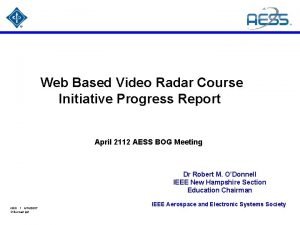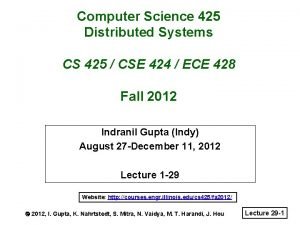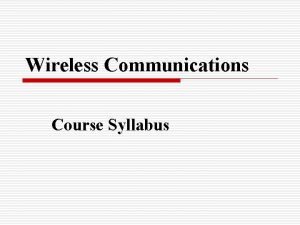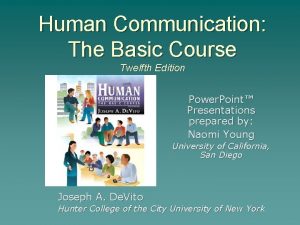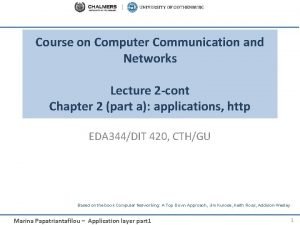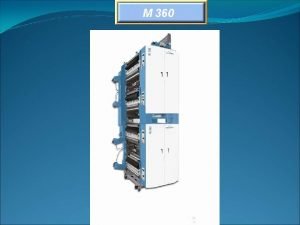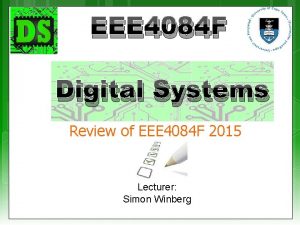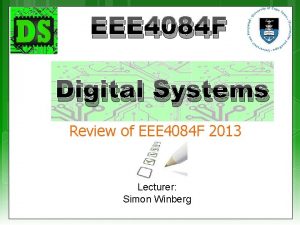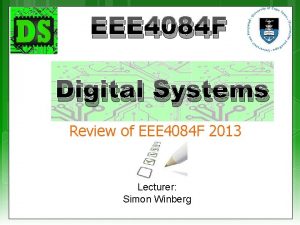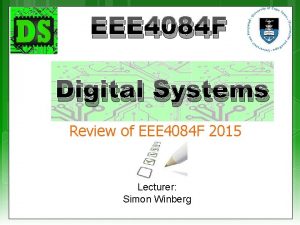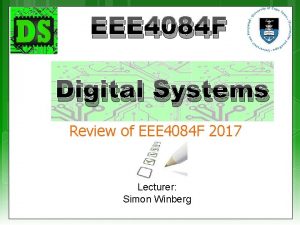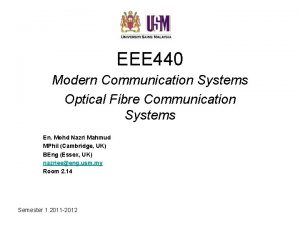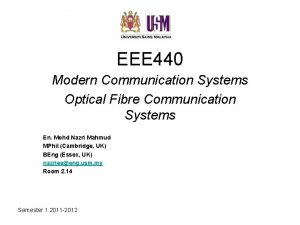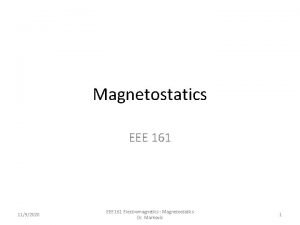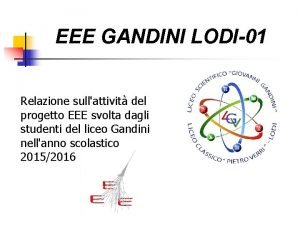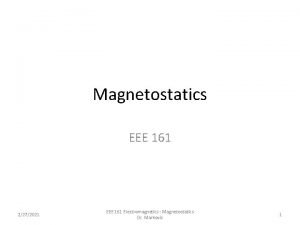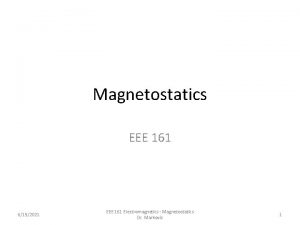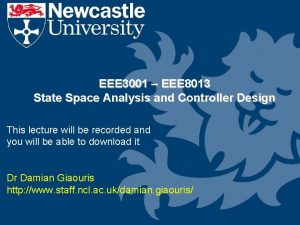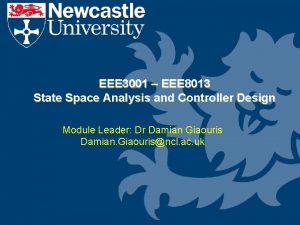EEE 360 Communication Systems I Course Contents Chapter



























































- Slides: 59

EEE 360 Communication Systems I Course Contents Ø Ø Ø Chapter Chapter 1: Introduction 2: Signals and Spectra 3: Base Band Pulse and Digital Signaling 4: Band Pass Signaling Principles & Circuits 5: AM, FM and Digital Modulated Systems. Lecturer: Prof. Dr. Erhan A. İnce Eeng 360 Communication Systems I Department of Electrical and Electronic Engineering Eastern Mediterranean University Eeng 360 1

Chapter 1 INTRODUCTION Chapter Objectives: Ø Ø Ø How communication systems work. Frequency allocation and propagation characteristics. Computer solutions using MATLAB. Information measure. Coding performance. Lecturer: Prof. Dr. Erhan A. İnce Eeng 360 Communication Systems I Department of Electrical and Electronic Engineering Eastern Mediterranean University Eeng 360 2

What is a communication system? . Ø Communication systems are designed to transmit information from one place to an other. Ø Communication systems and design concerns: • • Selection of information–bearing waveform; Bandwidth and power of the waveform; Effect of system noise on the received information; Cost of the system. Eeng 360 3

Digital and Analog Sources and Systems Basic Definitions: • Analog Information Source: An analog information source produces messages which are defined on a continuum (space-time). (e. g. Microphone) • Digital Information Source: A digital information source produces a finite set of possible messages. (e. g. Typewriter) x(n. T) x(t) n t Analog Digital Output of a sample and hold circuit Eeng 360 4

Digital and Analog Sources and Systems Ø A digital communication system transfers information from a digital source to the intended receiver (also called the sink). Ø An analog communication system transfers information from an analog source to the sink. Ø A digital waveform is defined as a function of time that can have a discrete set of amplitude values. Ø An Analog waveform is a function that has a continuous range of values. Eeng 360 5

Digital Communication Ø Advantages • Relatively inexpensive digital circuits may be used; • Privacy is preserved by using data encryption; • Data from voice, video, and other sources may be merged and transmitted over a common digital transmission system; • In long-distance systems, noise dose not accumulate from repeater to repeater. Data regeneration is possible • Errors in detected data may be small, even when there is a large amount of noise on the received signal; • Errors may often be corrected by the use of coding. Ø Disadvantages • Generally, more bandwidth is required than that for analog systems; • Synchronization is required. Eeng 360 6

Synchronization A continuous stream of data signals is generally accompanied by timing signals (generated by an electronic clock) to ensure that the transmitter and the receiver are in step (synchronized) with one another. The data is sent in blocks (called frames or packets) spaced by fixed time intervals. In contrast, asynchronous transmission works in spurts and must insert a start bit before each data character and a stop bit at its termination to inform the receiver where it begins and ends. Most network protocols (such as Ethernet, SONET, Token Ring) use synchronous transmission whereas asynchronous transmission is used commonly for communications over telephone lines. Eeng 360 7

What is needed to decode the received signal? The receiver will have to determine where a signal cell (representing a bit) starts and ends in order to sample the signal as near at the middle of the signal as possible. It will have to know where a character or a byte starts or ends and, for packet based transmission, where each message block starts or ends. Finding out where a signal cell starts and ends is known as bit or clock synchronization, determining the character boundaries is known as character or byte synchronization and the last task is called block or frame synchronization. Eeng 360 8

Clocks running out of synchronization Imagine a communication system with two Data Terminal Equipments (DTEs) that have a major difference in the speed of their system clocks. The receiver's clock is running 12, 5% ahead of time than the sender's one. If the sender transmits a 8 -bit word, the receiver will interpret it as a 9 -bit word But as you have seen in the graphic above, the receiver will not only sample to many bits, but it will also sample the wrong bits. Eeng 360 9

Fig 1 a Transmitter and Receiver Clocks The transmitted signal (Fig. 1 a) consists of data that is clocked out at a rate determined by the transmitter clock. Signal transitions between zero and peak values contain the clocking information and detecting these transitions allows the clock to be recovered at receiver Fig 1 b Eeng 360 10

Eeng 360 11

All problems in digital networks, including poor synchronization, are manifested as errors. Examples of the results of poor synchronization are Ø Degraded speech quality and audible clicks Ø Degraded data traffic throughput Ø Call setup and management problems Ø Corrupt or incomplete fax messages Ø Low dialup modem speeds Ø Frozen-frames and audio pops on video transmissions Ø Call disconnects during mobile call hand-off Ø Partial or complete traffic stoppage Eeng 360 12

Encoding and Decoding for Digital Communication Ø Coding involves adding extra (redundant) bits to data to detect and/or correct errors at the output of the receiver. The disadvantage of these extra bits is to increase the data rate and the bandwidth of the encoded signal. We can also say it reduces the data rate if bandwidth is kept fixed. General Digital Communication System Eeng 360 13

Deterministic and Random Waveforms Ø A deterministic waveform can be modeled as a completely specified function of time. Ø A random waveform (or stochastic waveform) cannot be modeled as a completely specified function of time and must be modeled probabilistically. Ø In this course we will focus mainly on deterministic waveforms. Eeng 360 14

Block Diagram of A Communication System Ø All communication systems contain three main sub systems: 1. Transmitter 2. Channel 3. Receiver Transmitter Receiver Eeng 360 15

Block Diagram of A Communication System TRANSMITTER: Ø The signal-processing block is used for more efficient transmission. Examples: • • Ø In an analog system, the signal processor may be an analog low-pass filter to restrict the bandwidth of m(t). In a hybrid system, the signal processor may be an analog-to-digital converter (ADC) to produce digital signals that represent samples of the analog input signal. The transmitter carrier circuit converts the processed base band signal into a frequency band that is appropriate for the transmission medium of the channel. Example: • An amplitude –modulated (AM) broadcasting station with an assigned frequency of 850 k. Hz has a carrier frequency fc=850 k. Hz. The mapping of the base band input information waveform m(t) into the band pass signal s(t) is called modulation. It will be shown that any band pass signal has the form If R(t)=1 and θ(t) = 0, s(t) would be a pure sinusoid of frequency f=fc with zero bandwidth. Eeng 360 16

Block Diagram of A Communication System Channel: Ø Channels represents the path in which signals travel from transmitter to receiver. Very general classification of channels are: • Wire: Twisted-pair telephone line, coaxial cable, waveguide (microwave communication), and fiber-optic cables. • Wireless: Air, vacuum and seawater. In general, the channel medium attenuates the signal so that the delivered information deteriorated from that of the source. The channel noise may arise from natural electrical disturbances or from artificial sources. Transmitter Receiver Eeng 360 17

Block Diagram of A Communication System Receiver: Ø The receiver takes the corrupted signal at the channel output and converts it to be a base band signal that can be handled by the receiver’s base band processor. Ø The base band processor cleans up this signal and delivers an estimate the source information m(t) to the communication system output. Ø In digital systems, the measure of signal deterioration is usually taken to be the probability of bit error P(e) – also called Bit Error Rate (BER) of the delivered data m(t). Ø In analog systems, the performance measure is usually taken to be the Signal-tonoise Ratio (SNR) at the receiver output. Transmitter of Receiver Eeng 360 18

What makes a Communication System GOOD We can measure the “GOODNESS” of a communication system in many ways: Ø § § How close is the estimate • • • to the original signal m(t) Better estimate = higher quality transmission Signal to Noise Ratio (SNR) for analog m(t) Bit Error Rate (BER) for digital m(t) How much power is required to transmit s(t)? • Lower power = longer battery life, less interference How much bandwidth B is required to transmit s(t)? • • Less B means more users can share the channel Exception: Spread Spectrum -- users use same B. How much information is transmitted? • • In analog systems information is related to B of m(t). In digital systems information is expressed in bits/sec. Eeng 360 19

Eeng 360 20

Frequency Bands ØRegulations specify, modulation type, bandwidth, power, type of information and etc. that a user can transmit over designed frequency bands. ØFrequency assignments and technical standards are set internationally by International Telecommunication Union (ITU). ØEach nation of ITU retains sovregnity over spectral usage and standards adopted in its territory. ØEach nation is expected to abide by the overall frequency plan adopted by ITU. Eeng 360 21

q The entire range of electromagnetic radiation frequencies is called the electromagnetic spectrum. q The frequency range suitable for radio transmission, the radio spectrum, extends from 10 kilohertz to 300, 000 megahertz. It is divided into a number of bands, as shown in the next slide. Eeng 360 22

Allocation of Radio Spectrum (Frequency Allocations) wavelength frequency Eeng 360 23

Propagation of Electromagnetic Waves The propagation characteristics of electromagnetic waves used in wireless channels are highly dependent on the frequency. Ø Based on carrier frequency EM wave propagations can be classified as: • GROUND-WAVE PROPAGATION • SKY-WAVE PROPAGATION • Line of Sight (LOS) PROPAGATION Ø 24

Ionized Regions Above Earth. • Ionization of air is caused by UV rays from the sun. • Ionized air shows different properties at different levels (Density and pressure). • Speed of the wave differs with the changing properties. • Dominant regions are named as D, E, F 1 and F 2. 25

The Sun and the Ionosphere Sunspots affect the ionosphere because the areas around the spots emit greater amounts of the ultraviolet radiation—the main cause of ionization. . The D Layer This layer acts as an attenuator, especially at low frequencies. In fact, the That is, doubling the frequency reduces the level of attenuation by a factor of four. This is why low-frequency signals are prevented from reaching the higher layers, except at night when the D layer disappears. Eeng 360 26

Signals are attenuated as they pass through the D layer because they cause free electrons to vibrate. When this occurs, the electrons collide with other molecules, consuming a small amount of energy and dissipating a proportionately small amount of the radio signal. We can see that the level of attenuation depends upon the number of collisions that take place. In turn, this depends on a number of other factors. One of the most obvious is the number of gas molecules that are present. More gas molecules mean more collisions and increased attenuation. Ionization levels are also important, as is the frequency of the radio signal. As frequency increases, wavelengths become shorter and collisions between free electrons and gas molecules decrease. As a result, low-frequency signals are attenuated far more than those at higher frequencies. Eeng 360 27

GROUND-WAVE PROPAGATION or Surface Wave Propagation Ø Dominant mode of propagation for frequencies below 2 MHz. Ø Diffraction of the wave causes the wave to propagate along the surface of the earth. Ø This propagation mode is used in AM Radio Broadcasting. Ø Diffraction of waves in “D” layer helps propagation along the surface of earth. 28

Diffraction refers to various phenomena that occur when a wave encounters an obstacle or a slit. It is defined as the bending of light around the corners of an obstacle or aperture into the region of geometrical shadow of the obstacle Eeng 360 29

Polorization Radio waves produce both electric and magnetic fields. The direction of the electric component of the field is called the polarization of the electromagnetic field. Thus, if the electric component is vertical, the wave is said to be “vertically polarized, ” and if horizontal, “horizontally polarized. ” A wave traveling through space may be polarized in any direction. One traveling along the surface of the Earth is always vertically polarized because the Earth, a conductor, short-circuits any horizontal component. The magnetic field and the electric field are always mutually perpendicular. Eeng 360 30

Eeng 360 31

SKY-WAVE PROPAGATION Ø Dominant mode of propagation for EM waves in the frequency range of 2 MHz to 30 MHz. Ø Long coverage is obtained by reflection of wave at the ionosphere and at the Earth’s boundary. Ø This mode is used in HF band International Broadcasting (Shortwave Radio). Ø Sky-wave propagation is caused primarily by reflection from the F layer (90 to 250 miles in altitude). 32

Reflection vs Refraction The phenomenon of a light beam rebounding after hitting a surface is called reflection. To put it simply, the mirror images are what are called reflection generally. The light beam that hits the surface is called incident ray. The light beam that leaves the surface is called the reflected ray. There’s another phenomenon called refraction. Here, the light changes direction, or ‘bends’ as it passes through the boundary between these two media. The images that are witnessed through the glass/see-through objects are a result of refraction. Eeng 360 33

SKY-WAVE PROPAGATION Ø The refraction index of the ionosphere can be approximated as Where, n -- Refractive index, N -- Free electron density (number of electrons/m 3) ( ~ 1010/m 3) f -- Frequency of the wave (Hz). Ø Refractive index will change gradually with the altitude. 34

ØTraveling waves will gradually bend according to Snell’s law. nr Sin φr = ni Sin φi n for Light of Wavelength 600 nm Substance Air (1 atmosphere pressure, 0 degrees C) Refractive Index, n 1. 00029 Water (20 degrees C) 1. 33 Crown Glass 1. 52 Flint Glass 1. 66 ØWaves will be bent back to earth. Ionosphere acts as a reflector. Transmitting station will have coverage areas along the surface of earth. Eeng 360 35

LINE-OF SIGHT (LOS) PROPAGATION Ø Dominant mode of propagation for EM waves above 30 MHz. Ø Since the frequency is high, f 2 >> 81 N so that n ≈ 1 ( Free Space) Ø This mode can be used in Satellite Communications. Ø The disadvantage of LOS is that the signal path has to be above the horizon and the receiver antennas need to be placed on tall towers so that they can see each other. 36

Earth stations are designed to receive and transmit signals from or to a satellite in orbit. Eeng 360 37

Satellites can be in three different orbits 1) Geostationary orbit (geosynchronous orbit) 2) Polar circular orbit 3) Inclined highly elliptical orbit In this type of orbit the satellite takes 24 hours to circle once around the earth. Since period of revolution of the satellite is equal to the period of rotation of the earth the satellite appears stationary. Eeng 360 38

Eeng 360 39

Eeng 360 40

Goes over the poles and scans the whole earth in every 12 hours. Satellites used for weather monitoring is launched into polar circular orbits. Eeng 360 41

It is used for establishing communications with regions that are at high altitudes. Eeng 360 42

LOS Calculations Ø Let’s assume d = Distance to the horizon; h = Antenna height. . . r = Effective radius of earth Where h << r Ø Effective radius of earth = 4/3 * real radius Effective radius of earth r = 4/3 * 3960 = 5280 miles Converting feet to mile Example: For a television station with an h=1000 ft tower, d = √(2000) = 44. 7 miles. The transmitter will cover an area of 44. 7 miles around. 43

Measuring Information Ø Definition: Information Measure (Ij) The information sent from a digital source (Ij) when the jth massage is transmitted is given by: where Pj is the probability of transmitting the jth message. • Messages that are less likely to occur (smaller value for Pj) provide more information (large value of Ij). • The information measure depends on only the likelihood of sending the message and does not depend on possible interpretation of the content. • For units of bits, the base 2 logarithm is used; • if natural logarithm is used, the units are “nats”; • if the base 10 logarithm is used, the units are “hartley”. 44

Measuring Information Ø Definition: Average Information (H) The average information measure of a digital source is, – where m is the number of possible different source messages. – The average information is also called Entropy. information sent from a digital source when the jth massage is transmitted : (Ij) • Definition: Source Rate (R) The source rate is defined as, – where H is the average information – T is the time required to send a message. 45

Measuring Information-Example 1. 1 Ø Find the information content of message that consists of a digital word 12 digits long in which each digit may take on one of four possible levels. The probability of sending any of the four levels is assumed to be equal, and the level in any digit does not depend on the values taken on by pervious digits. Answer: Possible combinations of 12 digits ( # of possible messages) = 4 12 Because each level is equally likely, all different words are equally likely. 46

Channel Capacity & Ideal Comm. Systems Ø For digital communication systems, the “Optimum System” may defined as the system that minimize the probability of bit error at the system output subject to constraints on the energy and channel bandwidth. Ø Is it possible to invent a system with no error at the output even when we have noise introduced into the channel? Yes under certain assumptions !. Ø According Shannon the probability of error would approach zero, if R< C Where • R - Rate of information (bits/s) • C - Channel capacity (bits/s) Capacity is the maximum amount of information that a particular channel can transmit. It is a theoretical upper limit. The limit can be approached by using Error Correction Ø B - Channel bandwidth in Hz and Ø S/N - the signal-to-noise power ratio 47

Channel Capacity & Ideal Comm. Systems ANALOG COMMUNICATION SYSTEMS In analog systems, the OPTIMUM SYSTEM might be defined as the one that achieves the Largest signal-to-noise ratio at the receiver output, subject to design constraints such as channel bandwidth and transmitted power. Question: Is it possible to design a system with infinite signal-to-noise ratio at the output when noise is introduced by the channel? Answer: No! DIMENSIONALITY THEOREM for Digital Signalling: Nyquist showed that if a pulse represents one bit of data, noninterfering pulses can be sent over a channel no faster than 2 B pulses/s, where B is the channel bandwidth. 48

Problems 49

Problems 50

Channel Coding If the data received have too many errors for the desired use we can try reducing the error using 1) Automatic repeat request (ARQ) 2) Forward Error Correction (FEC) In an ARQ system. When receiver detects parity errors in a block of data, It requests that data is retransmitted. In FEC the transmitted data is encoded before transmission so that the receiver can detect error and also correct them. ARQ is often used in computer communication systems since it is inexpensive to implement. Since there is already a duplex channel the receiver can transmit back an acknowledgement (ACK) for correctly received data or Can request a retransmission (NAC). FEC techniques are used to correct errors on simplex (one-way) channels where ACK or NAC can be transmitted back. FEC is also preferred for systems with large transmission delays. Eeng 360 51

Coding involves adding extra (redundant) bits to the data stream so that the Decoder can reduce or correct errors at the receiver. Codes may be classified into two broad categories: 1. Block Codes A block code is a mapping of k input binary symbols into n output binary symbols. A block coder is a memoryless device. Block codes are denoted as (n, k) where the code rate R = k/n. 1. Convolutional Codes Convolutional code is produced by a coder that has memory. Convolutional coder accepts k binary symbols as input and produces n binary symbols as output. n output symbols are affected by v+k input symbols (memory is v) Code rate is R = k/n A small value for R indicates a high degree of redundancy which should provide more effective error control. Eeng 360 52

Block Codes Hamming weight of a code word is the number of binary 1 bits. i. e. 1 1 0 1 has hamming weight 4 Hamming Distance Hamming distance between two code words is denoted by d, and is the number of positions by which they differ. i. e. 110101 111001 d=2 Some of the errors can be detected and corrected If d >= s + t + 1 where s is the number of errors that can be detected t is the number of errors that can be corrected (s>= t) if d>= 2 t + 1 A pattern of t or fewer errors can be both detected and corrected. Eeng 360 53

Block Codes A general code word can be expressed as i 1 i 2 i 3 …… ik p 1 p 2 … pr k is the number of information bits, r is the number of parity check bits n is the total word length in (n, k) block code where n = k+r A Hamming code is a block code having a Hamming distance of 3. ( single error correcting code) d>= 2 t + 1 Only certain (n, k) codes are available: (n, k) = ( 2 m -1 , 2 m -1 -m) where m is an integer and m >= 3 Code rate R approaches 1 as m becomes large. Eeng 360 54

Convolutional Codes A convolutional encoder is depicted in the figure below: k=3, n=4, K=5 and R = 3/4 k bits (one input frame) are shifted in each time, and, concurrently, n bits (one output frame) are shifted out, where n > k Redundancy is provided in the output, because n > k Eeng 360 55

there is memory in the coder, because the output frame depends on the previous K input frames, where K >1 The code rate is which is R = k/n For this example R = ¾ The constraint length, K, is the number of input frames that are held in the k. K -bit shift register data from the k. K stages of the shift register are added (modulo 2) and used to set the bits in the n-stage output register. Eeng 360 56

For example, consider the convolutional coder shown in Fig. 1– 6. Here, k=1, n=2 and K=3. and a commutator with two inputs performs the function of a two-stage output shift register. The convolutional code is generated by inputting a bit of data and then giving the commutator a complete revolution. The process is repeated for successive input bits to produce the convolutionally encoded output. In this example, each input bit produces output bits, so the code rate is R = k/n = ½. Eeng 360 57

The code tree of Fig. 1– 7 gives the encoded sequences for the convolutional encoder example of Fig. 1– 6. To use the code tree, one moves up if the input is a binary 0 and down if the input is a binary 1. The corresponding encoded bits are shown in parentheses. Eeng 360 58

A convolutionally encoded signal is decoded by “matching” the encoded received data to the corresponding bit pattern in the code tree. In sequential decoding (a suboptimal technique), the path is found like that of a driver who occasionally makes a wrong turn at a fork in a road but discovers the mistake, goes back, and tries another path. An optimum decoding algorithm, called Viterbi decoding, uses a similar procedure. It examines the possible paths and selects the best ones, based on some conditional probabilities [Forney, 1973]. The Viterbi procedure can use either soft or hard decisions. Details for Viterbi decoding will not be given here. Eeng 360 59
 Eee 360
Eee 360 Entrepreneurship development training
Entrepreneurship development training Con 360 problem statement examples
Con 360 problem statement examples Eee kuet
Eee kuet Eee 322
Eee 322 Eee 121
Eee 121 Eee 431
Eee 431 Eee 302
Eee 302 Eee 302
Eee 302 Tahvel.edu.eee
Tahvel.edu.eee Eee 431
Eee 431 Eee 431
Eee 431 Eee 431
Eee 431 Eee 431
Eee 431 Eee 145
Eee 145 Eee
Eee Huffman coding
Huffman coding Eee 431
Eee 431 Eee 431
Eee 431 Eee g
Eee g Quality factor of rlc circuit
Quality factor of rlc circuit Dot product
Dot product Eee
Eee ëëë
ëëë Eee
Eee Android (linux-based)
Android (linux-based) Powere
Powere Cute pdf
Cute pdf Schematic arrangement of diesel power plant
Schematic arrangement of diesel power plant Eee
Eee Eee components
Eee components Eee office
Eee office Asus xgu2008
Asus xgu2008 Metu math 117
Metu math 117 Eee components
Eee components Eee 202
Eee 202 Soldier course vs sailor course
Soldier course vs sailor course Course title and course number
Course title and course number Course interne course externe
Course interne course externe Golf course drainage
Golf course drainage Dbms course outcomes
Dbms course outcomes Distributed systems course
Distributed systems course Radar systems engineering course
Radar systems engineering course Distributed systems course
Distributed systems course Wireless communication course syllabus
Wireless communication course syllabus Human communication the basic course
Human communication the basic course Computer communication course
Computer communication course Decision support systems and intelligent systems
Decision support systems and intelligent systems Dicapine
Dicapine Embedded systems vs cyber physical systems
Embedded systems vs cyber physical systems Engineering elegant systems: theory of systems engineering
Engineering elegant systems: theory of systems engineering Career portfolio definition
Career portfolio definition Deep perineal pouch contents
Deep perineal pouch contents Fresh frozen plasma contents
Fresh frozen plasma contents Febrile non hemolytic transfusion reaction
Febrile non hemolytic transfusion reaction Regio thorax
Regio thorax Popliteal fossa borders
Popliteal fossa borders Identify
Identify The immortal life of henrietta lacks table of contents
The immortal life of henrietta lacks table of contents Contents of internal capsule
Contents of internal capsule
